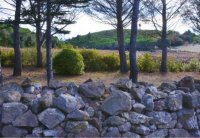Landscapes



Schist and basins
The mountains surrounding Cabrières form a natural amphitheater whose geology has led to this terroir’s centuries-old reputation. The vineyards are spread out amongst the garrigue and woods on soils of schist scree and shale with the Pic de Vissou (480m high) as their backdrop.
Stone-walled terraces
In the foothills of the Larzac, terraced vineyards have stabilized the limestone scree and improved the soil. A lot of hard work has been put into building stone walls, which characterize the landscape. The horizontal walls are intersected by vertical piles of stones that create a mosaic of different levels.
The “ruffes” of Lake Salagou
The red soil of Lake Salagou originates from the primary era, when the hot climate became dryer causing the iron salts in the soil to oxidize. The fine oxidized pebbles detach themselves from the mountains of the Hercynian era to form “ruffes”, which can build up to more than 2000m thick. Some of these ruffes, which are over 250 million years old, have been reclaimed by vines, mostly on the southern shore and on the flatter areas upstream of the lake.
Headlands and slopes
At the edge of the plains, the vineyards meet the foothills of the mountains leading to outstandingly beautiful landscapes where the vines meet the garrigue.
Plains and neighboring hills
Surrounded by hills, the plains around Gignac are remarkable and vineyards represent the main type of agriculture. They are interrupted by stretches of garrigue and stony limestone outcrops as well as olive groves. Together they offer a well cared for landscape of great quality.
Diverse wine-growing landscapes
Vines were introduced by the Phoceans who arrived in Agde in the 5th century B.C. Since then, wine growing has developed greatly in the Coeur d’Hérault due to the rich diversity of soils and terroirs. Today, vineyards occupy about 20% of the land.
The Cœur d’Hérault extends over 1300km2 and offers an incredible palette of remarkable and protected landscapes that will take your breath away. They are managed sustainably in order to preserve them while still welcoming huge numbers of visitors. These sites aside, you will find well-kept agricultural land everywhere in the Coeur d’Hérault and it is this that safeguards the way of life.






